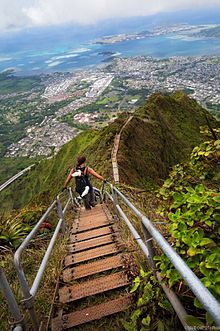Haiku Stairs

The Haʻikū Stairs, also known as the Stairway to Heaven or Haʻikū Ladder, is a steep hiking trail on the island of Oʻahu, Hawaii.[1] The total 3,922 steps span along Oahu's Ko'olau mountain range.[2]
"Haiku" does not refer to the Japanese poetry genre. The area is named "Haʻikū" after the Kahili flower.
Early history

In 1942, contractors for the U.S. Navy began construction of the Haʻikū Radio Station, a top secret facility that was to be used to transmit radio signals to Navy ships that were then operating throughout the Pacific.[3] In order to obtain the necessary height for the antennae, the Navy stretched them across Haʻikū Valley, a natural amphitheater. Some remnant parts of the wooden ladder may still be seen beside the metal steps.
The radio station was commissioned in 1943. To transmit such a powerful signal, the Navy needed a transmitter of greater capability than possible with vacuum tube technology at the time. They therefore decided upon an Alexanderson alternator, a huge device capable of generating powerful low-frequency radio signals, and requiring an antenna of heroic proportions.[3]
When the Naval base was decommissioned in the 1950s, the U.S. Coast Guard used the site for an Omega Navigation System station. In the mid-1950s, the wooden stairs were replaced by sections of metal steps and ramps — by one count, 3,922 steps. The station and trail were closed to the public in 1987. Some hikers ignored the "no trespassing" signs and continued to climb, contributing to the local community's misgivings about reopening the structure.
21st century
In 2003, the stairs were repaired, costing the city $875,000.[4]
In August 2012, Don Tiki show singer and comedian Fritz Hasenpusch died of a heart attack during his Haʻikū Stair climb.[5]
In 2014, six people were arrested and 135 were cited for climbing the stairs. The City Prosecutors Office said that criminal trespass in the second degree carries a $1000 fine.[6] Some local residents have installed "booby traps" to stop hikers from passing through their property to reach the stairs.[7] As of early 2018, City and County of Honolulu had stated that there was no plan to open the stairs for public use, citing liability concerns.
The Board of Water Supply voted unanimously on Monday, April 27, 2020 to transfer the Haiku Stairs over to the city since the stairs were a liability that did not align with the agency’s mission. The city plans to turn the trail into a paid attraction. The city had 18 months to take over or the stairs will be torn down.[8] The city took possession on July 1, 2020.[9]
References
- ^ "The Friends of Haiku Stairs". Friendsofhaikustairs.org. Archived from the original on April 20, 2008. Retrieved September 4, 2010.
- ^ "Surviving the Stairway to Heaven". untappedcities.com. Alysha mendez. Retrieved January 8, 2015.
- ^ a b "History of the haiku stairs". haikustairs.org. Retrieved January 8, 2015.
- ^ "Stairway to Heaven, Oahu". To-hawaii.com. Retrieved August 23, 2010.
- ^ Kubota, Gary T. (August 7, 2012). "Haiku Stairs hike victim is identified as Don Tiki singer Fritz Hasenpusch". Honolulu Star-Advertiser. Retrieved July 4, 2020.
{{cite news}}: CS1 maint: url-status (link) - ^ Cruz, Catherine. "Crackdown on hikers at Haiku Stairs". Retrieved March 23, 2017.
- ^ Davis, Chelsea. "Injured hiker: 'Booby trap' set up to deter Haiku Stairs trespassers". Retrieved July 21, 2018.
- ^ Davis, Chelsea. "Haiku Stairs gets reprieve from demolition, but now city needs to take action". Retrieved April 28, 2020.
- ^ "City to make Hawaii's 'Haiku Stairs' a public attraction". KITV. July 3, 2020. Retrieved July 4, 2020.
{{cite news}}: CS1 maint: url-status (link)
External links
 Media related to Haiku Stairs at Wikimedia Commons
Media related to Haiku Stairs at Wikimedia Commons
